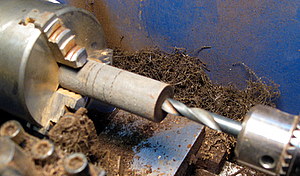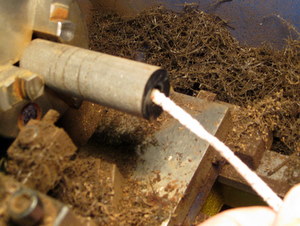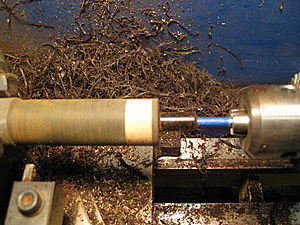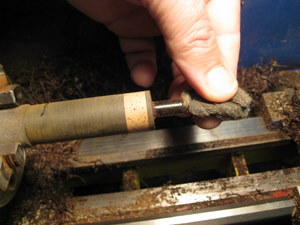Using Delrin Tenons
The Kurt Huhn Method
Intro
The basis for this article originally appeared as a sticky on the Pipe Makers Forum, and written by Kurt Huhn:
First, decide on your tenon diameter. Most folks will use 5/16", but 3/8" and 1/4" are not uncommon.
Next, find a drill bit that's going to give you the right size hole for your delrin. As any machinist will tell you, 5/16" is not 5/16" from one drill bit or piece of stock to the next. In this case, you can count on the delrin being the same size, as these are manufactured to rather close tolerances. Like it or not, you're going to need to experiment on briar. other woods will not react the same as briar to drilling, and will not give you an accurate gauge of hole size. Scraps of briar are fine, as long as you can drill them using the same methods you intend to use when you make a pipe.
Have a selection of drill bits handy. Use bits from different manufacturers, as one manufacturer may have different tolerances than another. The design of the drill bits may also play a part in making a hole that's final size is different from other bits. Drill with these bits using the same methods of pipe manufacturing - the methods you use will be important in determining final hole size.
It's important to note that you MUST clear the wood chips frequently while drilling the mortis. If the wood chips build up, it will generate excess heat and pressure which will change the final hole size as those wood chips press against the sides of the mortis.
Once you have a drill bit that you know will provide a consistent hole size, you're ready to start using it. Be aware, that the bit that provides the right hole size for briar, may be too small for drilling a hole in vulcanite or acrylic. You'll need to be sure of your drill bits before you start.
My procedure is as follows:
Drill the briar:
- chuck the block in and line everything up along my construction lines for airway, mortis, and tobacco chamber. I drill the mortis/airway first.
- set the spindle speed for 500RPM or less.
- face the shank with a 1-1/4" precision Forstner bit. I take care not to use to heavy or aggressive a hand in this step. You want to avoid grain tearout.
- drill the mortis, about 3/4 of a turn of the tailstock at a time. This works out to about 1/12 or so of an inch for each advancement. After each advancement, I remove the bit completely from the hole, and clear all the dust and chips. The depth is roughly 1/2" inch when the mortis is completely drilled (at this point I continue on with the airway and tobacco chamber, that's not covered here.)
Drill the stem:
- I chuck the rod stock and face with a 1-1/4" precision Forstner bit
- I drill the stock somewhat more aggressively than the briar. Vulcanite, Cumberland, and acrylic are more stable than briar under heat and pressure while drilling. Don't go too nuts here, because you can burn the mortis in the stem if you use too much pressure or speed.
- total hole depth in the stem material is about 1/4" to 1/2" depending on stem shape.
- I also use a bit that gives me a flat bottom in the stem mortis. This way the amount of epoxy in contact with the smoke is minimal, and the opportunity for a void at the end of the delrin is minimal.
- continue to drill the airway in the stem
Drill the airway in the delrin:
- Slice off a length of delrin approximately the length I need. I usually go about an 1/8" longer just to be sure I can bottom out the tenon in the mortis in the stummel.
- I set the spindle speed to about 1200 RPM to drill delrin. Delrin is extremely stable under heat and pressure, and is self-lubricating. This also mitigates any risk you might have of using too much forward pressure and setting the drill bit off-course.
- I do not face the delrin
- I use a short drill bit, or a jobber drill bit with most of it's length swallowed up in the chuck. This helps prevent the bit from wandering.
- after drilling, I use the tip of a skew chisel to cut 3 or 4 grooves in the delrin where it will be epoxied to the stem material. This is necessary, since delrin will not take adhesives very well.
Put the stem and delrin together:
- first, I take a triangle file and slightly deepen the grooves on at three points around the circumference. Do not deepen the grooves all the way around. The goal is to get a slight triangle shape in the grooves so that the delrin will not rotate in the stem once the epoxy has cured. Just a couple swipes of the file in each groove at 120-degree intervals should be quite sufficient to hold it.
- mix up some epoxy (5-minute, 15-minute, 24-hour, whatever) with a toothpick
- use the toothpick to put a dollop of epoxy in the stem mortise
- spread epoxy all over the outside of the delrin. Be sure to get epoxy in the grooves and get all the big air bubbles out.
- insert the delrin tenon into the mortise. Epoxy will go everywhere, this is normal.
- at this point you can either wipe up the excess epoxy with a rag or paper towel, or you can wait a couple minutes and just peel it off when it becomes rubbery. Be sure to get it all, otherwise your stem won't fit right.
- after the epoxy has fully cured, you can remove the epoxy that got into the airway by carefully re-drilling the airway. I do this by hand, holding the stem and with a tapered drill bit turning on the lathe at 500RPM. BE CAREFUL!!
- now you can sand or file off whatever excess delrin there is so that you get a nice tight stem/shank meeting.
Conclusion:
That's it in a nutshell. Sounds like a lot of work, but it goes rather quickly for me as I tend to batch most of that by doing 3-4 stems at a time. Way less time than trying to hand turn tenons on a wood lathe. I also prefer the buttery feel of delrin as a tenon over vulcanite - but that's primarily a personal preference.
Revised Method w/Photos
Intro
The following outlines a method used allowing the stem and Delrin to be drilled together after the two are assembled. As with any aspect of pipe making, there are many ways to achieve good results with Delrin. The following method is constantly evolving, but may prove helpful to some in developing their own. The pictures show insert material. For more information on using inserts see Stem Inserts.
Preparing the stem
Note: If convenient, consider leaving the stem material in the lathe for the entire process (glue up and drilling). This prevents having to re-center it for drilling operations. Multiple sessions where the stem is in and out of the lathe can introduce problems, even with self-centering chucks.
Prepare the stem material in the lathe by first roughing in the diameter of the stem rod by turning it down. Then face the end as you would normally. The following pics show that being done with a Forstner bit:
Drilling
The diameter of the Delrin used for the tenon will largely depend on the pipe's final stem and shank diameter. It is critical that your drills match the Delrin you're using, especially with regard to the fit of the tenon in the stummel mortise. Both drills and Delrin vary slightly, so some experimentation with speed, feed rate, and different drills, even of the same marked size will result it the best fit. Once you find a good drill, make sure you keep track of it. It may be advantageous to use a different drill for the stummel than the one used for the stem material.
Prepping the Delrin
Next measure and cut the section of Delrin to be used. Make sure you leave extra length to allow for trimming it to perfectly match the depth of the mortise. Here we are also gluing up insert material, so that is also accounted for in the length:
Round the end of the Delrin to match the bottom of the hole drilled in the stem material. This will minimise any voids and pockets of epoxy:
Glue up
First dry fit everything to ensure your fit is good:
Roughing up the Delrin, and the hole in your stem material will greatly improve the bond between the two materials:
Then mix up epoxy and coat both surfaces of both the hole of the stem and the end of the Delrin (as well as both surfaces of any insert material being used):
Use a thin even film of epoxy. Rotate and press all the materials against each other to release any air bubbles and squeeze out any extra epoxy:
Carefully wipe away any squeeze out off of the tenon (the squeeze out around and insert materials can be easily trimmed when it's dry, but the tenon should stay as clean as possible). Then use the trimming tool in the cross carriage of the lathe to press the insert materials against the main stem and to each other and lock it into position. Use something chucked into the tail stock to press the Delrin firmly into the stem while the epoxy sets, and lock it into position.
These serve as excellent clamps. If possible, let all this sit overnight, or until well cured (5 minute epoxy will speed the set time in terms of clamping, but will still not be fully cured for some time. It is risky to drill and fit the stem assembly until it is fully cured). When ever possible, I leave the assembly in the lathe through the entire process. During cold or damp weather I leave the light down close over the assembly (as shown above) while the epoxy is curing.
Fitting to the stummel
Now that our epoxy is fully cured we can fit the Delrin tenon to the mortise. First bevel the tenon so it will not damage the mortise in the stummel, then check the stummel and measure how much to trim off the tenon:
Next we transfer the measurement to the stummel and trim the Delrin:
Next we bevel the tenon again, and recheck that we have it correctly fit to the mortise:
Drilling
With the tenon correctly fit we can proceed to drill. Using a center drill/countersink first will ensure a nicely centered and secure start to the drilling operation, as well as providing a nice counter sunk draft hole:
Next we measure for the depth of the first drilling. Shown is a 5/32" tapered drill, which does an excellent job of drilling. 5/32" tapered also provides an open draw while tapering down to a smaller hole. Stop about 1/2" to 3/4" short of the end and then follow with a 1/16" drill on through the stem. This last section will eventually flatten out and be funneled wider at the bit end of the stem to provide for a continuous airflow, and yet facilitate a thin comfortable bit:
The drilling is done very slowly in terms of speed and feed rates, and the drill removed often to cool and clear chips. The drill should not be too hot to touch:
Next we change to the 1/16" drill, and drill completely through the stem. Again, this must be done very slowly and the drill removed to clear chips:
Cleaning up
The draft hole can be sanded up through most of it's length by wrapping sandpaper around the 1/16" drill bit. The final 3/4" or so cannot be reached, but it will be carefully opened, filed, sanded, and buffed later. Steel wool does a nice job cleaning up the tenon end after the sanding.
Finish
Here we see the tenon finished, and then the final check with the stummel:
And now the fun really begins!
































